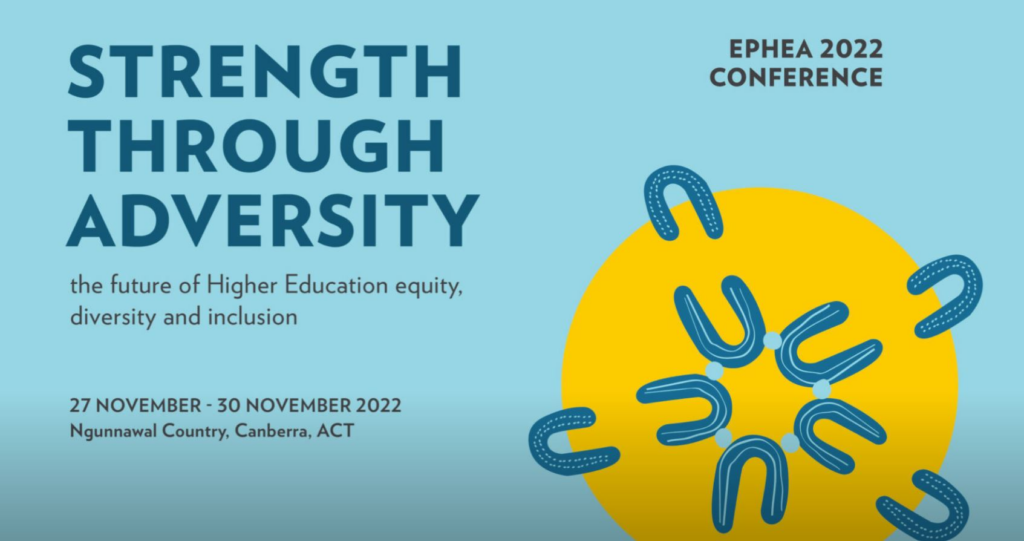![Featured image for “Diversity Atlas Newsletter [November 2022]”](https://diversityatlas.io/wp-content/uploads/2022/12/resize-rubxs.jpeg)
New Industries, Ideas and Innovation
This newsletter, we’re wrapping up the year by taking a look at an upcoming 2022 EPHEA conference, highlighting our participation in the 2022 International Mining and Resources Conference, reviewing a keynote speech by our CTO Rezza Moieni, spotlighting an upcoming event on our diversity calendar and providing this month’s product update!

2022 EPHEA Conference
Diversity Atlas will be attending the 2022 Equity Practitioners in Higher Education Australasia (EPHEA) conference, held in Canberra with the theme Strength Through Adversity: the future of Higher Education Equity, Diversity and Inclusion.
The aim of the conference is to support equity policy and practice in the higher education sector. This year’s conference will feature inspiring keynote speakers, cutting-edge workshops, research and special interest groups, networking opportunities and social and cultural events.
Diversity Atlas, our world-first data analysis tool, will be used to map the diversity of the attendees and participants of the event via a short voluntary survey.
The results of the survey will be presented on the second day of the event and a summary of the results will be shared in a comprehensive report after the event.
Diversity Atlas is one of the most inclusive and secure surveys of its kind in the world, with a database of over 45,000 different human identity points. Click this link to find out more about the upcoming event.

The International Mining and Resources Conference
The Diversity Atlas team were invited by Global Victoria to travel to Sydney for the 2022 International Mining and Resources Conference (IMARC), where our CEO and Founder Peter Mousaferiadis gave a keynote speech.
IMARC brings together thought leaders and the most influential people in the mining industry. The event serves as a meeting ground to network and discusses ground-breaking technology to elevate the mining industry. This year’s event hosted more than 7,500 attendees from more than 100 countries around the world.
The Diversity Atlas team held a booth at the event and showed how our unique diversity data-analysis platform can be used to improve sustainability in the mining industry. Our platform reveals statistical insights which support organisations in tracking the progress of their environmental, social, sustainability and development governance goals (or SDGs and ESGs).
Peter spoke on sustainability in his keynote speech, emphasising that the most underutilised resource is our collective heritage.
“The question is, why are we not drawing on this asset as a source of innovation, progress and sustainability, reducing poverty and social cohesion for everyone?”
Peter Mousaferiadis, Founder and CEO
An article based on Peter’s speech can be accessed on our blog. Click here to read Approaching Planet.

2022 World Conference on Arts, Humanities and Social Sciences
Our Chief Technology Officer Rezza Moieni delivered a keynote speech in Bangkok at the 2022 World Conference on Arts, Humanities and Social Sciences (WCAHSS) hosted by Eurasia Conferences.
The WCAHSS hosted researchers, scholars, academics and leading research organisations to share advances in Arts, Humanities and Social Sciences across the world.
Rezza presented a discussion on his latest research paper titled ‘A Study on Diversity Prediction with Machine Learning and Small Data’. Diversity data collection is still a fairly new concept. The paper analyses recent discussions in the media regarding the importance of diversity, to minimise gaps between minority and majority communities.
Rezza discussed how organisations are now seeking to plan their diversity strategies and goals for the long term. Organisations may, for example, want to know how long it will take to close the gender gap, or what the diversity of their team will look like over the next five years.
To map their progress in measuring success and minimising gaps not just now but into the future, organisations want the ability to predict the diversity of their community.
Rezza’s paper studies the different models for forecasting diversity in Australia, using Net Overseas Migration and census data, to help predict the country of birth, language and religion of residents of Australia from 2022 to 2025.
‘A Study on Diversity Prediction with Machine Learning and Small Data’ will be published on our website in the near future. Read more of Rezza’s work here.
New Features and Updates

Diversity Calendar Spotlight
This month, we’re spotlighting the International Day of Commemoration and Dignity of the Victims of the Crime of Genocide and of the Prevention of this Crime in our Diversity Calendar, on 9 December.
Established by the United Nations (UN) in 2015, this day marks the anniversary of the 1948 Convention on the Prevention and Punishment of the Crime of Genocide (Genocide Convention), which was the UN’s first human rights treaty. It signifies commitment to ensure the prevention of this ‘crime of crimes’.
The UN encourages all its member and observer states, organisations, other international and regional organisations and civil society, including NGOs and individuals, to observe this day.
The UN aims to raise awareness of the Genocide Convention and its role in combating and preventing the crime of genocide as defined in the Convention and to commemorate and honour the victims of genocide.

Product Update
In this product update, Diversity Atlas’ Cultural Attaché, Quincy Hall, introduces three key insights about Gen Z.
Crystal Ball: Let’s look into the future. Three AMAZING things about Gen Z.
Doris Day sang:
Que sera, sera
Whatever will be, will be
The future’s not ours to see
Que sera, sera
I take a bit of an issue with that third line. The future may not be ours, but, to an extent, we can see it.
Coinciding with our CTO Rezza Moieni’s recent talk and paper on the topic of Diversity Prediction, for this month’s product update I am going to cheat a bit. Rather than talk about the product itself, I want to chat about what the product reveals, which is an update of sorts as it is the first time we’ve released these insights, and it contains insights that to the best of my knowledge and Googling haven’t been quantified or qualified to any great level. Yet. Let’s be the first to dip our toes in. Let’s talk about Gen Z (aged 26 and under) – and think of Gen Z now as future leaders.
Across multiple regions, multiple industries, multiple job roles and hierarchical placement, we see in Gen Z some trends, and yet, for every trend, there exists a multitude of ‘terms and conditions apply’ disclaimers.
1. Gen Zers are notably less likely to be religious; except in countries where religion is of higher importance. In fact, in these ‘more religious’ regions, Gen Z are more likely to be religious, and even if they are less likely it is to a much smaller degree than in the former countries.
This is mind-blowing to consider, and so interesting to me that once I looked at the data I had trouble sleeping. It’s not just companies that should have a think about this; it has geo-political ramifications as well. Secularist nations might be looking at other nations where church and state are more closely intertwined and think that if they just wait a generation or two, the relationship will ease or even unravel, but our data points towards this not necessarily being the case. As mentioned above, there’s a lot of ‘terms and conditions’ to apply, with some of them being that industries differ, job function differs, even departments differ in the same building, but the trend is noticeable and requires planning and thought. Our sample size is too small to yet make any definitive statements but we’ll continue to monitor the data. I should point out that as part of our Diversity Atlas deployment, we ask participants about their cultural and/or social identity priority. In some countries (e.g: Australia, Netherlands) ‘My religion’ is around the 10th highest priority. It is in these countries (and others) we see Gen Z consistently being less likely to be religious. But in other countries, in the Middle East and Africa for example, religion can be as high as ‘1’ on their identity priority selections, and it is in these regions we see examples of Gen Z being more religious than their older colleagues. As mentioned above, there’s a lot of ‘terms and conditions’ to apply, some of them being that industries differ, job function differs, even departments differ in the same building, but the trend is noticeable and requires planning and thought.
2. Speaking of one’s cultural and/or social identity priority, globally, across all our customers, we see ‘My occupation’ usually around the 5th most important priority. But not for Gen Z … 10th. This makes perfect sense. When I was in my early 20s, I considered work as that thing I unfortunately had to do to pay for my weekends (especially when for six months I worked in a clothing factory putting the tightening cord in tracksuit pants).
It seems intuitive; the younger cohort are less likely to feel connected to their employer or job role, and it would be a good idea for employers to start including Gen Z in future planning initiatives if they are not already. But guess what’s not intuitive? That ageing them doesn’t seem to change it. That is, 18-22, it’s 10th. 22-26, 10th still. What it implies (and we’ll have to wait more than a decade to prove it) is that those who are Gen Z right now, putting ‘my occupation’ as their 10th highest priority? It might still be 10th when they are hitting 40. Attention all employers: You will need to plan for this. I am looking into my crystal ball and I see terms like ‘profit share’ and ‘flexible work arrangements’ becoming more and more crucial to retaining talent.
3. They are more likely to identify as LGBTQIA+. There’s no evidence that they are more likely to be LGBTQIA+, but they are more likely to identify as such in every region, every industry, every hierarchical position. This includes Europe, USA, Africa, Middle East, Asia-Pac. Everywhere. Always. This might be something you already knew, but we have actual data that can let companies know that there is a rainbow wave coming, and if you’re not inclusionary, you’re going to be excluded from the future talent pool. The future leaders pool.
Signed, Quincy Hall, spokesperson for the Grumpy Gen X-ers.
Business closure over the holiday period.
Our office will be closed from Thursday the 22nd of December until Tuesday the 3rd of January. If you’d like to contact us during this period, please email [email protected], or, contact us here.
Share this Post